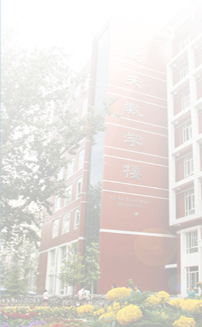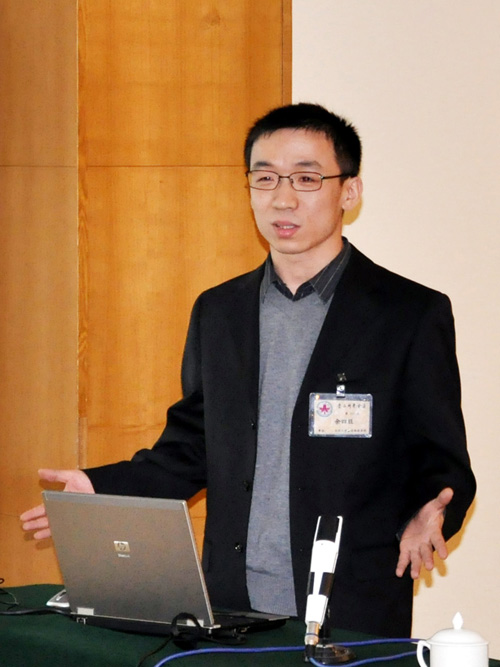

Siwang Yu: PhD. Associate professor.
Dept. Chem. Biol. School of Pharmaceutical Sciences. Peking University Health Science Center
Tel: +86-10-82801539
Email:swang_yu@bjmu.edu.cn
Lab homepage: http://www.chemoprevention.net
Address: Peking University School of Pharmaceutical Sciences, Rm. 308. 38# Xueyuan Rd., Haidian Dist., Beijing, P. R. China .
Postal code: 100191
Personal information
Dr. Siwang Yu graduated with a B. E. from Sichuan Institute of Science and Technology in 1996, then obtained his M. Sc. from Huazhong University of Science and Technology in 2000. In 2003 he graduated with Ph. D. from Peking University School of Pharmaceutical Sciences for his research in the biological effects of lanthanides and underlying cellular and molecular mechanisms. After that he went to USA and joined Ah-Ng Tony Kong’s lab in Ernest Mario School of Pharmacy at Rutgers, The State University of New Jersey as a postdoctoral associate, studying carcinogenesis and cancer chemoprevention. Dr. Yu is now an associate professor in the Department of Chemical Biology, Peking University School of Pharmaceutical Sciences, with his research interests specially focusing on preventive pharmaceutics.
Research interests
The major research interest in Dr. Yu’s lab is Preventive Pharmaceutics, which combines knowledge and methods of chemistry, biology and clinical medicine to discover chemopreventive agents that intervene in the development and progress of major chronic diseases such as cancer and diabetes.
The studies in Dr. Yu’s lab focus on 1) personalized biomarkers of carcinogenesis and chemo toxicities; these biomarkers often are also targets of chemotherapies or alternative/complementary drugs. 2) Discovery of chemopreventive agents based on personalized prediction of predisposition to certain outcomes, such as tumor development, drug resistance or toxicity. These agents could be natural phytochemicals, synthesized chemicals, biological agents, or clinically applied drugs.
Ongoing researches
1、Investigation on the roles of stress responsive transcription factors in carcinogenesis, drug resistance and toxicity/side effects of chemotherapies, and interventions targeting these factors.
2、Utilization and mechanisms of chemicals derived from traditional Chinese herb medicine and edible plants as chemopreventive agents against cancer and diabetes.
Recent publications (in chronological order)
1. Gao Z, Zhang C, Yu S*, Yang X*, Wang K, Vanadyl bisacetylacetonate protects β cells from palmitate-induced cell death through the unfolded protein response pathway, J Biol Inorg Chem. 2011;16(5):789-98
2. Cheung KL, Yu S, Pan Z, Ma J, Wu TY, Kong AN, tBHQ-Induced HO-1 Expression Is Mediated by Calcium through Regulation of Nrf2 Binding to Enhancer and Polymerase II to Promoter Region of HO-1, Chem Res Toxicol, 2011 Epub ahead of print.
3. Que LL, Wang HX, Cao BS, Yang XD, Wang K, Yu SW*, The regulation and functions of transcription factor Nrf2 in cancer chemoprevention and chemoresistance, J Chin Pharm Sci 2011 20 (1): 5-19
4. Yu S, Khor TO, Cheung K-L, Li W, Wu T-Y, Huang Y, Foster BA, Kan YW, Kong AN, Nrf2 Expression Is Regulated by Epigenetic Mechanisms in Prostate Cancer of TRAMP Mice. PLoS One. 2010 Jan 5;5(1):e8579
5. Khor TO*, Yu S*, Barve A, Hao X, Hong JL, Lin W, Foster B, Huang MT, Newmark HL, Kong AN. Dietary Feeding of Dibenzoylmethane Inhibits Prostate Cancer in Transgenic Adenocarcinoma of the Mouse Prostate Model. Cancer Res 2009; 69(17):7096-102. * Khor T and Yu S contributed equally to this work.
6. Prawan A, Saw CL, Khor TO, Keum YS, Yu S, Hu L, Kong AN. Anti-NF-kappaB and anti-inflammatory activities of synthetic isothiocyanates: effect of chemical structures and cellular signaling. Chem Biol Interact 2009;179(2-3):202-11.
7. Yu S, Shen G, Khor TO, Kim JH, Kong AN. Curcumin inhibits Akt/mammalian target of rapamycin signaling through protein phosphatase-dependent mechanism. Mol Cancer Ther 2008;7(9):2609-20.
8. Prawan A, Keum YS, Khor TO, Yu S, Nair S, Li W, Hu L, Kong AN. Structural influence of isothiocyanates on the antioxidant response element (ARE)-mediated heme oxygenase-1 (HO-1) expression. Pharm Res 2008;25(4):836-44.
9. Nair S, Hebbar V, Shen G, Gopalakrishnan A, Khor TO, Yu S, Xu C, Kong AN. Synergistic effects of a combination of dietary factors sulforaphane and (-) epigallocatechin-3-gallate in HT-29 AP-1 human colon carcinoma cells. Pharm Res 2008;25(2):387-99.
10. Li W, Yu S, Liu T, Kim JH, Blank V, Li H, Kong AN. Heterodimerization with small Maf proteins enhances nuclear retention of Nrf2 via masking the NESzip motif. Biochim Biophys Acta 2008;1783(10):1847-56.
11. Li W, Khor TO, Xu C, Shen G, Jeong WS, Yu S, Kong AN. Activation of Nrf2-antioxidant signaling attenuates NFkappaB-inflammatory response and elicits apoptosis. Biochem Pharmacol 2008;76(11):1485-9.
12. Khor TO, Yu S, Kong AN. Dietary cancer chemopreventive agents - targeting inflammation and Nrf2 signaling pathway. Planta Med 2008;74(13):1540-7.
13. Khor TO, Huang MT, Prawan A, Liu Y, Hao X, Yu S, Cheung WK, Chan JY, Reddy BS, Yang CS, Kong AN. Increased susceptibility of Nrf2 knockout mice to colitis-associated colorectal cancer. Cancer Prev Res (Phila Pa) 2008;1(3):187-91.
14. Cheung KL, Khor TO, Yu S, Kong AN. PEITC Induces G1 Cell Cycle Arrest on HT-29 Cells Through the Activation of p38 MAPK Signaling Pathway. AAPS J 2008;10(2):277-81
15. Barve A, Khor TO, Nair S, Lin W, Yu S, Jain MR, Chan JY, Kong AN. Pharmacogenomic Profile of Soy Isoflavone Concentrate in the Prostate of Nrf2 Deficient and Wild-Type Mice. J Pharm Sci 2008; 97(10):4528-45
16. Yu S, Kong AN. Targeting carcinogen metabolism by dietary cancer preventive compounds. Curr Cancer Drug Targets 2007;7(5):416-24.
17. Shen G, Khor TO, Hu R, Yu S, Nair S, Ho CT, Reddy BS, Huang MT, Newmark HL, Kong AN. Chemoprevention of familial adenomatous polyposis by natural dietary compounds sulforaphane and dibenzoylmethane alone and in combination in ApcMin/+ mouse. Cancer Res 2007;67(20):9937-44.
18. Kwon KH, Barve A, Yu S, Huang MT, Kong AN. Cancer chemoprevention by phytochemicals: potential molecular targets, biomarkers and animal models. Acta Pharmacol Sin 2007;28(9):1409-21.
19. Yuan X, Xu C, Pan Z, Keum YS, Kim JH, Shen G, Yu S, Oo KT, Ma J, Kong AN. Butylated hydroxyanisole regulates ARE-mediated gene expression via Nrf2 coupled with ERK and JNK signaling pathway in HepG2 cells. Mol Carcinog 2006;45(11):841-50.
20. Yu S, Hu J, Yang X, Wang K, Qian ZM. La(3+)-induced extracellular signal-regulated kinase (ERK) signaling via a metal-sensing mechanism linking proliferation and apoptosis in NIH 3T3 cells. Biochemistry 2006;45(37):11217-25.
21. Xu C, Yuan X, Pan Z, Shen G, Kim JH, Yu S, Khor TO, Li W, Ma J, Kong AN. Mechanism of action of isothiocyanates: the induction of ARE-regulated genes is associated with activation of ERK and JNK and the phosphorylation and nuclear translocation of Nrf2. Mol Cancer Ther 2006;5(8):1918-26.
22. Lin W, Shen G, Yuan X, Jain MR, Yu S, Zhang A, Chen JD, Kong AN. Regulation of Nrf2 transactivation domain activity by p160 RAC3/SRC3 and other nuclear co-regulators. J Biochem Mol Biol 2006;39(3):304-10.
23. Li W*, Yu SW*, Kong AN. Nrf2 possesses a redox-sensitive nuclear exporting signal in the Neh5 transactivation domain. J Biol Chem 2006;281(37):27251-63. *Li, W and Yu, S equally contributed to this paper
24. Keum YS, Yu S, Chang PP, Yuan X, Kim JH, Xu C, Han J, Agarwal A, Kong AN. Mechanism of action of sulforaphane: inhibition of p38 mitogen-activated protein kinase isoforms contributing to the induction of antioxidant response element-mediated heme oxygenase-1 in human hepatoma HepG2 cells. Cancer Res 2006;66(17):8804-13.
25. Hu J, Yu S, Yang X, Wang K, Qian Z. Lanthanum induces extracellular signal-regulated kinase phosphorylation through different mechanisms in HeLa cells and NIH 3T3 cells. Biometals 2006;19(1):13-8.
26. Yu S, Yuan L, Yang X, Wang K, Ke Y, Qian ZM. La3+-promoted proliferation is interconnected with apoptosis in NIH 3T3 cells. J Cell Biochem 2005;94(3):508-19.
1. Kui Wang, Siwang Yu and Tianlan Zhang, Arsenic in Traditional Chinese Medicine, p113 – 133, in Biological Chemistry of Arsenic, Antimony and Bismuth, edited by Dr. Hongzhe Sun, 2011 John Wiley & Sons, Inc., ISBN: 978-0-470-71390-7
2. Siwang Yu,Ka Lung Cheung, Wenge Li and Ah-Ng Tony Kong, Plant Phenolic Compounds - modulation of cytoprotective enzymes and Nrf2/ARE signaling, p402-426, in Plant Phenolics and Human Health: Biochemistry, Nutrition, and Pharmacology, edited by Dr. Cesar G Fraga,2009 John Wiley & Sons, Inc., ISBN: 978-0-470-28721-7
Lab members
Graduates
Wei Huang (huangwei-04@126.com)
Liyan Ji (gileeyan0402@163.com)
Zhifang Zhang (zhangzf_smile@163.com)
Huixia Wang (alicy1988@126.com)
Linling Que (twiggy123@163.com)
Wanwan Ma (mawanwanxiaoma@163.com)
Undergrads
Simin Yang (yangsimin16@163.com)
Shunan Tang (tangshunan1990@126.com)
Xinzhu Wang (viola0920@163.com)
Yumeng Tian (zjjtianyumeng@tom.com)